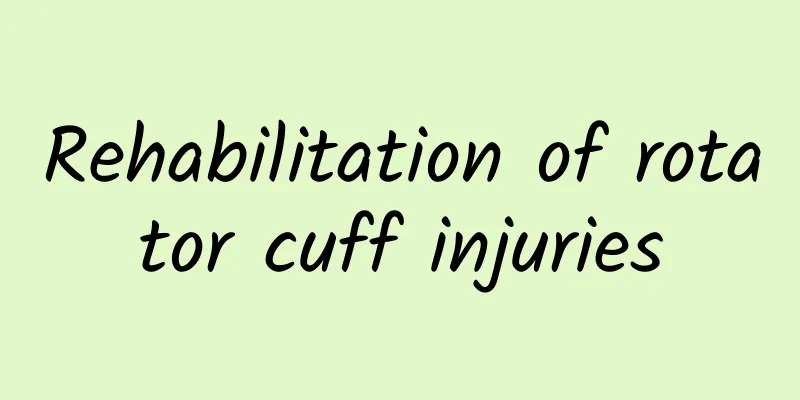Rehabilitation of rotator cuff injuries

|
What is the rotator cuff? The rotator cuff muscles are composed of the supraspinatus, infraspinatus, teres minor and subscapularis. These four muscles form a sleeve-like tendon structure in front, above and behind the humeral head. They have the functions of maintaining the airtightness of the joint cavity, supporting and dynamically stabilizing the glenohumeral joint, preventing the humeral head from moving upward, ensuring the smooth completion of shoulder abduction, internal rotation and external rotation, and maintaining the stability of the shoulder joint. Plays an important role. How does rotator cuff injury occur ? Rotator cuff injury is the injury of one or more tendons in the shoulder joint. Improper exercise or repeated strain can easily damage the stable structure of the shoulder joint and cause rotator cuff injury. Due to the excessive activity of the greater tuberosity of the humerus, especially the abduction movement, the acromion and the acromion coracoacral ligament are constantly rubbed. This repeated abnormal movement can cause primary injury to the rotator cuff tendons and involve the upper and lower tissues. Some elderly people like to use fitness equipment to exercise. The shoulder rotation on the horizontal bar or rings, the sudden back extension during weightlifting and snatching, etc., are easy to injure the rotator cuff. Regularly playing tennis, baseball, volleyball, climbing and other sports that require the upper limbs to be raised above the head can also easily cause rotator cuff injuries over time. Signs of rotator cuff injury 1. Pain: It is the main symptom in the early stage. The pain is aggravated during shoulder flexion, abduction and rotation. It is mainly located in the anterolateral side of the shoulder joint and can radiate to the upper arm and neck. It is aggravated at night and after fatigue, and relieved by rest. There is tenderness in the gap between the anterior and lower end of the acromion and the greater tubercle of the humerus. Some patients with rotator cuff tears have a pain arc of 60°-120° when the shoulder joint is abducted. 2 Limited movement: Commonly, the abduction of the shoulder joint is limited. In severe cases, it is impossible to complete the arm-raising movements such as combing hair, but passive movement is normal. Many people accidentally find that it is difficult to complete movements such as combing hair, dressing, washing face, and putting hands on waist. In severe cases, the function of the elbow joint may also be affected. 3. Tenderness Most patients can feel obvious tenderness points around the shoulder joint, mostly at the greater tuberosity of the humerus or the subacromial space. 4. Muscle spasms and atrophy Atrophy of the supraspinatus and infraspinatus muscles, especially the infraspinatus muscle, can occur 2-3 weeks after rotator cuff injury. If it lasts more than 3 months, contracture of the soft tissue around the shoulder joint may occur, and the range of motion of the shoulder joint may be limited to varying degrees. 5. Abnormal noise: Gravel sounds can be heard or friction can be felt when moving. Rotator cuff injury classification Complete tear Small tear: the anterior-posterior diameter of the tear is less than 1 cm Moderate tear 1-3cm Large tear 3-5cm Large tear of 5 cm or more How to check for rotator cuff injury Special tests Supraspinatus muscle examination - empty can test The shoulder is abducted 90 degrees and forward 30 degrees, with the thumb facing down. One person applies downward resistance, and the subject lifts up to resist. If there is pain and weakness in the shoulder, it is positive, indicating supraspinatus injury. Infraspinatus, teres minor - resisted external rotation test The upper arm is close to the side of the body, the forearm is flexed 90 degrees, and one person applies resistance from the outside, and the subject resists external rotation. If pain occurs, it is positive, indicating injury to the infraspinatus and teres minor muscles. Subscapularis lift test Place the back of your hand on your lower back, with your palm facing backwards, and ask the subject to lift their hand off their back, with appropriate resistance if necessary. If the subject cannot lift their hand off their back, it is a positive test, indicating a subscapularis injury. Pain arc: When the upper limb is abducted and raised to 60° to 120°, the stress on the rotator cuff is the greatest, resulting in pain in the front of the shoulder, which is a positive sign of pain arc syndrome. Testing 1. X-ray 2. MRI is currently the most effective imaging method for examining rotator cuff injuries 3. Ultrasound 4. Arthroscopy Shoulder arthroscopy is a minimally invasive examination method, generally used for suspected rotator cuff injury, labral lesions, biceps long head tendon tear lesions and glenohumeral joint instability. Observe whether the bursal surface of the rotator cuff is damaged or the tendon is partially torn, and whether there are osteophytes or other impact factors under the acromion. While observing in the mirror, push and pull the glenohumeral joint in different directions to understand the stability of the joint. Rehabilitation of rotator cuff injuries If you find that your shoulder suddenly hurts and you don't know why, please seek medical attention immediately and complete treatment and recovery under the guidance of a doctor. Do not practice on your own to avoid delaying the condition or making it worse. After confirming the rotator cuff injury and classification, you can try a home rehabilitation program under the guidance of a physician. 1. Relax tense muscles, such as pectoralis minor, levator scapulae, etc. 2. Strengthen relaxed muscles, such as serratus anterior, trapezius, etc. 3. Improve the mobility of the thoracic spine and chest 4. Improve neck stability 5. Progress step by step: You can start practicing with minimal resistance or against your own weight, such as external rotation resistance training. 6. Principle of moderation: Rehabilitation training is different from conventional strength training. During the exercise, the muscles or related tissues should not be overly fatigued, otherwise it will be detrimental to their recovery. 7. Pain-free principle: If pain occurs during exercise, you should stop immediately or change to a more comfortable exercise. Increase joint mobility: Note: 1. Carry out daily life within the pain-free range; 2. Avoid excessive flexion and abduction of the shoulders, and avoid lifting heavy objects; 3. Do not pull excessively or make sudden movements to avoid impact. |
<<: The “removal or retention” of wisdom teeth, you will understand if you read this patiently!
>>: Can’t move your fingers? Let’s talk about “trigger finger”
Recommend
What causes endometrial thickening during ovulation?
The endometrium is one of the most important comp...
What is the reason why women have many dreams?
I believe that everyone will dream, especially wh...
How to use Quanjian effervescent tablets and their efficacy
I believe that everyone’s understanding of Quanji...
How to remove body odor
There are many common physical problems. When you...
What to do if endometrial thickening and bleeding do not stop
Endometrial hyperplasia is the proliferation of u...
Yellow-green discharge from the urethra
During physical examinations, human excrement is ...
How long can you store breast milk in a bottle?
Many women have a lot of breast milk after giving...
Is uterine cyst serious? What are the dangers?
Uterine cyst is a relatively common disease. It i...
Is crying in the wind a disease?
Due to the recent snowfall, the temperature has d...
What is the cause of watery leucorrhea?
Women are prone to many diseases. When treating w...
The delivery man thought it was hot and dizzy, so he went to the hospital for a checkup and found out that his eyes were sick.
Mr. Zou (pseudonym), who thought that his vision ...
Anyone had chest tightness right after pregnancy?
Expectant mothers do not need to panic after they...
Uterine cavity separation should be prevented in this way
Uterine separation is a common gynecological dise...
The best age to have a baby
introduce Recently, flash marriages have become p...
Gynecological inflammation self-examination table pictures
Nowadays, many female friends are confused by gyn...









